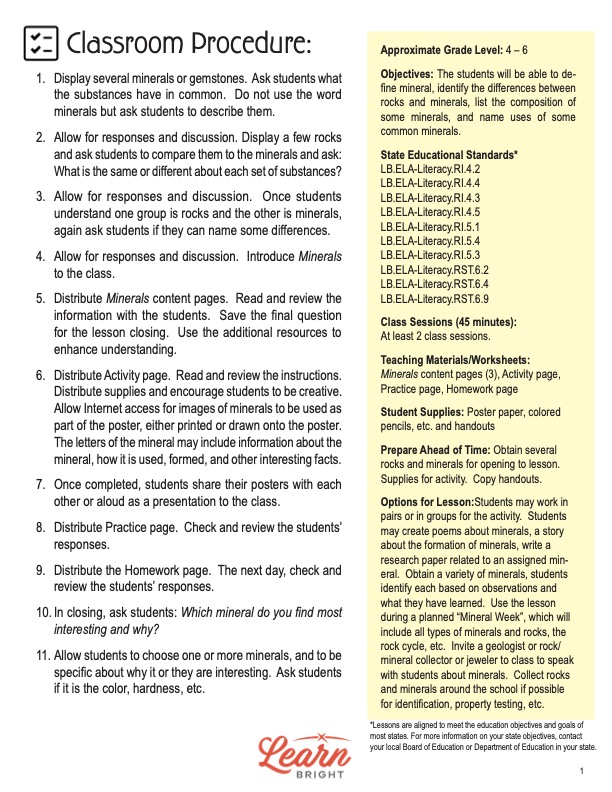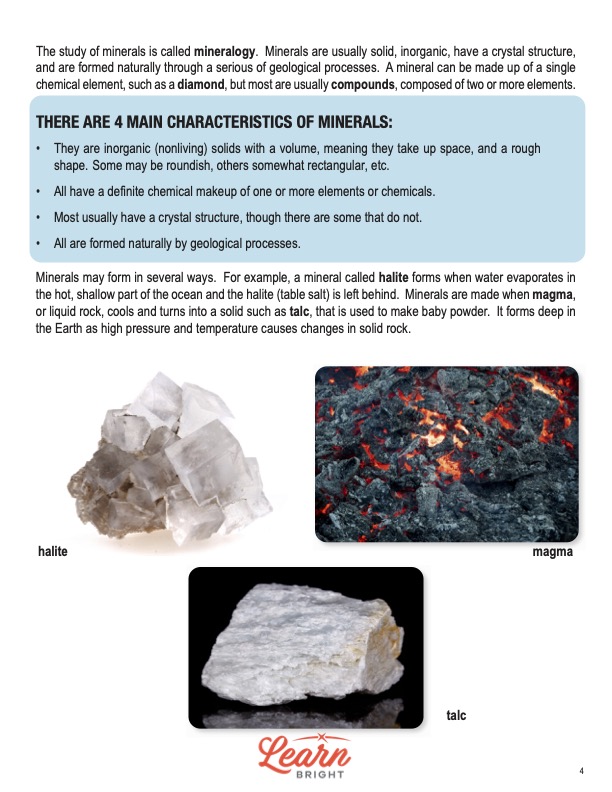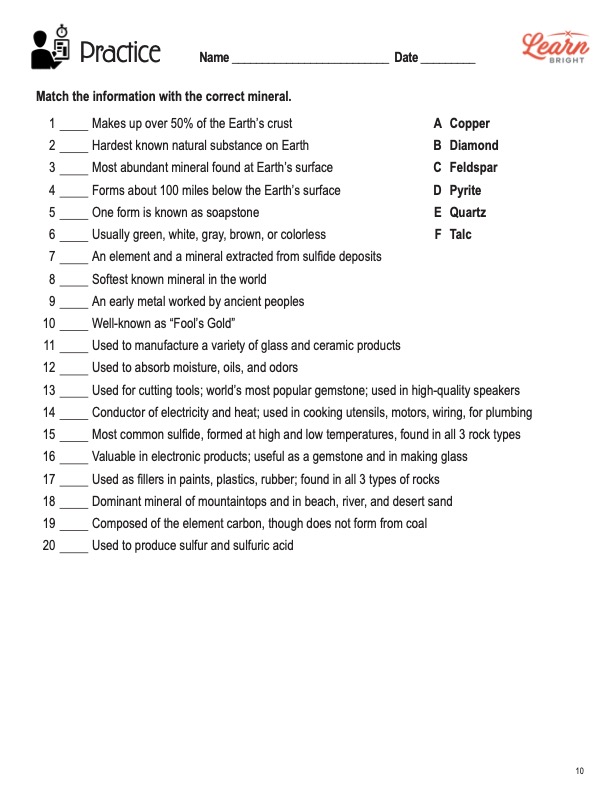Description
What our Minerals lesson plan includes
Lesson Objectives and Overview: Minerals explores the properties of this class of rocks. Students will discover that there are several types of mineral rocks and will learn what factors help scientists classify them. They will also learn about the composition and names of several specific minerals. This lesson is for students in 4th grade, 5th grade, and 6th grade.
Classroom Procedure
Every lesson plan provides you with a classroom procedure page that outlines a step-by-step guide to follow. You do not have to follow the guide exactly. The guide helps you organize the lesson and details when to hand out worksheets. It also lists information in the yellow box that you might find useful. You will find the lesson objectives, state standards, and number of class sessions the lesson should take to complete in this area. In addition, it describes the supplies you will need as well as what and how you need to prepare beforehand. This lesson requires poster paper and colored pencils or other colored writing utensils.
Options for Lesson
The “Options for Lesson” section of the classroom procedure page lists a lot of additional ideas and suggestions. One idea is to have students create poems or write stories about minerals. Students could also write research papers on a specific type that you assign. If you can, you could obtain a number of minerals and have students identify them based on what they’ve learned and what they observe. Another option is to plan a “Mineral Week” during which you teach this lesson in conjunction with others about rocks, the rock cycle, geology, and so on. You could invite a geologist, rock collector, or jeweler to speak with the class and answer questions.
Teacher Notes
The paragraph on this page gives you a little more information on the lesson overall and describes what you may want to focus your teaching on. It reminds you that the focus of this lesson is to help students understand the difference between minerals and rocks. The blank lines are available for you to write out any thoughts or ideas you have as you prepare.
MINERALS LESSON PLAN CONTENT PAGES
Minerals versus Rocks
The Minerals lesson plan contains six content pages. It starts off by asking students when a rock is not a rock. The answer: when it is a mineral. A mineral is a naturally occurring solid substance made from a single element or a combination of elements. Mineral examples include diamond, halite, jade, and nearly 4,000 more. Elements are pure substances made from a single type of atom. They are the building blocks for all matter in the world. Examples of elements include hydrogen, oxygen, gold, and over a hundred more.
On the other hand, a rock is a mixture of one or more minerals. It could come from a single mineral, but many rocks usually contain two or more minerals. Rocks are solids that form naturally, but that is where the similarities stop. Two samples of the same type of rock may have different kinds of minerals in them. However, a mineral always contains the same materials or elements in nearly the same proportions.
For example, if we found an igneous rock called granite in the backyard, it will not likely be the same as a piece of granite a thousand miles away. They may comprise different kinds of minerals. However, if we find a mineral called ruby in Australia, it will have a similar makeup as a ruby we find in India. The diagram on the first page may help explain the difference between rocks and minerals. Elements make up the minerals, and (usually) several minerals make up a rock.
Characteristics of Minerals
The study of minerals is called mineralogy. Minerals are usually solid, are inorganic, have a crystal structure, and form naturally through geological processes. A mineral can contain a single chemical element. Such is the case with the mineral diamond. But most are usually compounds, which means they contain two or more elements.
There are four main characteristics of minerals.
- They are inorganic (non-living) solids with a volume, meaning they take up space, and a rough shape. Some may be round, others rectangular, etc.
- All have a definite chemical makeup of one or more elements or chemicals.
- Most usually have a crystal structure, though there are some that do not.
- All are formed naturally by geological processes.
Students will discover that minerals can form in several ways. For example, halite forms when water evaporates in the hot, shallow part of the ocean. It leaves behind the halite, which is actually table salt. Minerals also form when magma, or liquid rock, cools and turns into a solid such as talc, which is used to make baby powder. It forms deep in the earth as high pressure and temperature causes changes in solid rock.
Physical Properties
Scientists define all minerals by their physical and chemical properties. When we observe and examine a mineral, we can determine some of its properties without special equipment. Physical properties include crystal structure, hardness, streak, luster, cleavage, fracture, gravity, and color.
A crystal’s atoms form an orderly 3D pattern. Every mineral has its own crystal structure even if it has the same chemical composition. Diamond and graphite both consist only of carbon, but they have different crystal structures and properties.
We can determine the hardness of a mineral using the Mohs hardness scale. Talc is the softest, and diamond is the hardest. Streak refers to the color of a mineral when it is ground to a powder. The luster of a mineral relates to how it appears in light, and cleavage is how it splits along various planes. Fracture relates to how a mineral breaks against its natural cleavage points.
Each mineral has a specific gravity, which is its density compared with water. Color, of course, simply refers to the color of a mineral as it appears. In addition to physical properties, every mineral has a definite chemical makeup. Scientists classify minerals into groups based on their chemical makeup.
Chemical Properties
There are thousands of minerals, but there are only about 30 that are common in the earth’s crust. These are called rock-forming minerals. The common minerals come together to make up the three types of rocks. There are many mineral groups, but the four common groups of minerals include silicates, carbonates, oxides, and sulfates.
Silicates are the most common. All silicate minerals contain oxygen and silicon that have joined together. Examples include aluminum, magnesium, iron, quartz, and mica. Carbonates are the second-most common group. They all contain carbon and oxygen together. Calcite is a carbonate the is really common in seashells.
The next group is oxides. This group contains most refined metals, like tin and copper. Oxides consist of an elements joined with oxygen. Finally, students will learn about sulfates. Sulfates commonly form in areas of slow evaporation. They occur where hot waters are forced through rock, which is the case with geysers.
About 99% of all the minerals found in the earth’s crust consist of just eight elements. These are oxygen, aluminum, silicon, iron, calcium, sodium, potassium, and magnesium. There are also certain minerals, such as iron, that our bodies need to help keep us healthy and strong.
Mineral Examples
The lesson provides information about six specific minerals in a chart for students to review. The first is feldspar, which makes up over half of the earth’s crust. We can find feldspar in all three types of rocks. Manufacturers use it to make a variety of glass and ceramic products. People also use it as filler in paints.
Diamond is the hardest known natural substance on Earth. It only contains the element carbon. And contrary to popular belief, diamonds do not form from coal. On the contrary, they form about 100 miles below the earth’s surface. People use it for a lot of practical purposes, and it has become the world’s most popular gemstone.
Another mineral students will learn about is pyrite. Pyrite is brass yellow and has a bright metallic luster. It is the most common sulfide and forms at both high and low temperatures. A famous nickname that many students will likely know is “fool’s gold” because of how similar it looks to gold. While it isn’t gold itself, it is used as an ore of gold.
Copper is another mineral students will discuss. In fact, it is both a mineral and an element. Rarely do we find copper in large quantities. Normally, miners extract it from sulfide deposits. It is probable that early peoples worked with copper. It is an excellent conductor of electricity and heat, so we can find it in many cooking utensils and motors.
MINERALS LESSON PLAN WORKSHEETS
The Minerals lesson plan includes three worksheets: an activity worksheet, a practice worksheet, and a homework assignment. Each one will help students solidify their grasp of the material they learned throughout the lesson. You can refer to the classroom procedure guidelines to know when to hand out each worksheet.
ACROSTIC POEM ACTIVITY WORKSHEET
Students will create an acrostic poem using the letters from their favorite mineral. They can use either a word or sentence for each letter. They will also add color and images, either ones they draw or find in others sources. The goal is for them to be creative.
MATCH THE MINERAL PRACTICE WORKSHEET
For the practice worksheet, students will match descriptions with the correct mineral. A word bank contains six possible options for minerals that the descriptions will match. In total, there are 20 descriptions.
MINERALS HOMEWORK ASSIGNMENT
The homework assignment divides into three sections. The first section requires students to match descriptions to the correct physical property of a mineral. There are 10 descriptions but only eight options in the word bank. Students will use two options twice.
For the second section, students will review five descriptions and decide which group of minerals the description relates. There are four options to choose from, so students will use one of the answers twice. The final section requires students to mark five statements as either true (T) or false (F).
Worksheet Answer Keys
There are answer keys at the end of the lesson plan document for the practice and homework worksheets. Correct answers are all in red to make it easy to compare to students’ responses. If you choose to administer the lesson pages to your students via PDF, you will need to save a new file that omits these pages. Otherwise, you can simply print out the applicable pages and keep these as reference for yourself when grading assignments.









